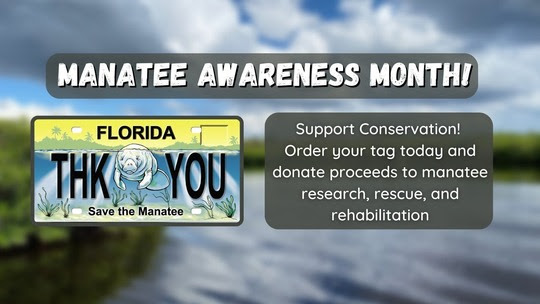FWRI Celebrates Manatee Awareness Month!Cold weather is here, and manatees have started to migrate to their winter warm water refuge. Remind boaters to go slow and look out below as manatees are on the move! As always, our rescue teams stationed throughout the state are on call to respond to manatees in need! Just this year, our teams, along with our partners and fellow members of the Manatee Rescue & Rehabilitation Partnership (MRP), have responded and rescued a total of 130 manatees throughout the state! These rescues are made possible in part by funding from the Save the Manatee Trust Fund. You can help support manatee research, rescue and conservation efforts today by getting your very own manatee license plate. *Report sightings of sick, injured, orphaned or dead manatees to our Wildlife Alert Hotline: 888-404-FWCC (3922).* 
Freaky Flounder
No, you're not seeing double. This is a rare instance of a flounder with full pigment on both the "eye" side and the "blind" side, known as "complete ambicoloration." Typically, larval flounder start out swimming upright in the water column with an eye on each side, and then undergo metamorphosis in the first few weeks of their life. One eye migrates to join the other on one side of their head, their body flattens out as they start swimming parallel to the bottom, and pigment develops on the “eye” side, while the “blind” side that rests on the bottom remains white. These adaptations are thought to help the flounder have a wider field of view as they burrow in the sand to hide from predators and ambush their prey. Pigment mutations in flounder are common in aquaculture, but extremely rare in the wild. A local fisherman, Jeremy Goodrich, caught this Southern flounder (Paralichthys lethostigma) near Oak Hill in the Mosquito Lagoon over the Veteran's Day weekend, and gave it to Rick Riley, an FWC scientist, at the Indian River Lagoon Field Lab in Melbourne. Watch a short video here! 
Largest Remaining Florida Scrub Jay Population
The Ocala National Forest (ONF) is home to the largest remaining population of Florida scrub-jays (Aphelocoma coerulescens), and in recent years, the US Forest Service has set aside large “Scrub-Jay Management Areas” to be burned and managed as early successional scrub. This exciting new program is the largest scrub restoration project in Florida. For the past 80 years, most of the sand pine forest in ONF has been managed for pulpwood harvest, in rotations of 40-50 years. After the pines are clearcut for harvest, the young, regenerating scrub oaks provide good scrub-jay habitat. Eventually, the regenerating sand pines outgrow the scrub oaks, and the process starts again once the next rotation begins. FWC researchers have completed a decade-long population study in the ONF where we color banded more than 800 scrub-jays. The Ocala National Forest is a birdwatching treasure. Learn more about the ONF and find wildlife viewing areas on the US Forest Service Website. The most conservative population models from this study suggest that the population is between 1,800 and 1,900 family groups, which makes up more than 35% of the state population! Learn more about the Florida Scrub-Jay on our webpage. 
First Right Whale Calf Spotted!
Catalog #1612 ‘Juno’ is the first right whale sighted with a newborn calf this winter. The calf is no more than five days old. Catalog #1612 is at least 38 years old, and this is her 8th calf documented by researchers. She last gave birth four years ago during the 2019-2020 season.
These critically endangered whales are a long-lived species and have shown that they can rebound if given the opportunity. Throughout the 1990s and 2000s, the number of right whales slowly increased to a high of almost 500 individuals in 2010, but the population has been in a steep decline since, dropping to about 350 individuals and only 70 breeding females. Vessel strikes and entanglement in commercial fishing gear, like lobster and crab pots, are the primary threats to right whales. Read more about right whale population recovery and management on NOAA's webpage. Please use caution while boating and report right whale sightings to 877-WHALE-HELP (877-942-5343) or to the U.S. Coast Guard on VHF Ch. 16. Photo Credit: Clearwater Marine Aquarium Research Institute, taken under NOAA permit #26919. Funded by United States Army Corps of Engineers. 
Native Pollinator Research
Pollinating insects are essential for maintaining biodiversity in terrestrial ecosystems. In this video, FWRI researchers describe their ongoing efforts to document and understand native pollinator diversity in fire-maintained longleaf pine savannas. You can watch the video on our YouTube channel. New on MyFWC.com/ResearchWe hope you enjoy these articles that have been recently added/updated on our website: Red Tide Current Status
Red Tide Related Hotlines and Information Sources
Annual Rescue Summaries (Manatee)
Red Tide Manatee Mortalities
2023 Manatee Mortalities
HAB Publications
FWC's Third Update to the Statewide Florida Manatee Abundance Estimate
HAB Monitoring Database
Stone Crab Catch Data
Coral Bleaching
Update on Carcass Examinations in the Atlantic Unusual Mortality Event
New Publications Our MissionThrough effective research and technical knowledge, we provide
timely information and guidance to protect, conserve, and manage
Florida's fish and wildlife resources. | 






No comments:
Post a Comment